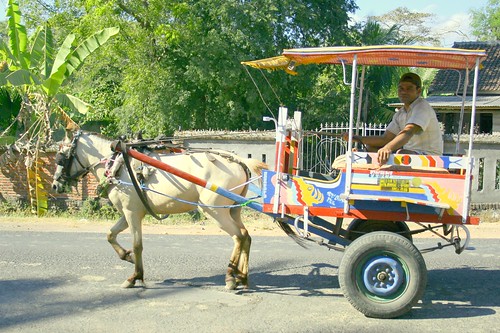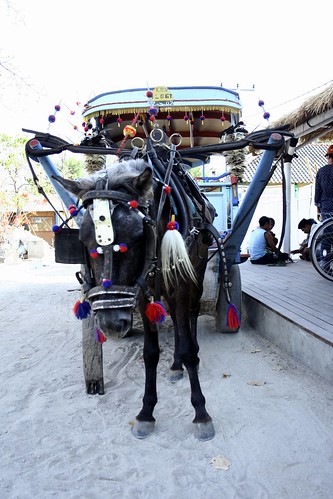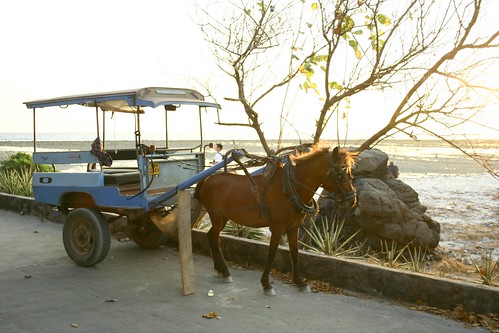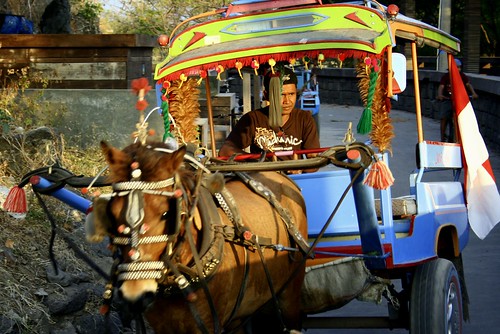Cidomo- Lombok’s horse-drawn cart
The horse is a beast of burden utilized for human and cargo transport for centuries. Different societies have various horse-driven carts but ever since the invention of the car, they have become obsolescent. While images of royal carriages, Western stagecoaches or old frontier wagons are still indelibly etched in the modern mind, they are paraded only in ceremonial affairs, touted as leisurely promenades for tourists or displayed as relics in museums.
In the Philippines, the horse carts, invariably called as the calesa, tartanilla or caratela, have also become rare, having been relegated in the most far-flung nooks in the countryside. The same is true in Indonesia. Bali’s version, the dokar is mostly for curious foreigners nowadays and Java’s andong or the delman are being pushed more and more into rural areas.
In the island of Lombok, there is one particularly unique variation, the cidomo, which remains highly popular. It is all over the towns, even in the islets as a means of public transportation.
Cidomo is a contraction from three words:
CI, for cikar, a traditional handcart
DO, for dokar, a pony cart
MO, for mobil, or sometimes montor, the car
The unique thing with the cidomo is that the cart uses car wheels instead of the regular wooden spoked wheels. Obviously, the preference was born of practicality as probably, automobile wheels, albeit expensive than wooden wheels, are longer lasting and easier to procure. Whatever the reasons are, the cidomo remains popular in Lombok, especially in routes which the public utility bemoh (vans) or bis (buses) do not ply. 
Canon EOS 350D Digital, 1/800s, f/4.0, 27mm, ISO 100, +1/3EV
Keruak, Lombok Timor, Nusa Tenggara Barat, Indonesia
The cidomo design is basic. Seats are arranged sideways. While they are often padded, they are not the most ergonomic in comfort. To put more load on the wheels, the cart is made to actually tilt slightly at the rear so the cart jiggles. Most first-timers get unnerved when getting on and off. A see-saw balance is not one thing we practice a lot in everyday life.
Canon EOS 350D Digital, 1/100s, f/3.5, 22mm, ISO 100
Gili Trawangan, Lombok, Nusa Tenggara Barat, Indonesia
Modernization, howevery, is creeping up. Already, in Mataram, Lombok’s capital city, the cidomo’s routes have been curtailed from the main hi-ways as they slow down vehicular traffic and pose as safety hazards. 
Canon EOS 350D Digital, 1/80s, f/4.0, 22mm, ISO 100, +1.0EV
a “parked” cidomo at Gili Trawangan, Lombok, Nusa Tenggara Barat, Indonesia
Meantime, cidomo continues to be a charming way to get around. Think of bells chiming with the gallops, bright painted patterns competing with yarn bonbons and tassels, and well, some malodorous poop dropping here and there. This is what local color (or smell) should be- raw, earthy and memorable.
Canon EOS 350D Digital, 1/80s, f/5.6, 55mm, ISO 100
Gili Trawangan, Lombok, Nusa Tenggara Barat, Indonesia






1 comment:
The horses that have to live and work on these islands, lead a miserable life because their owners do not know how to take care of them properly.
ABRUPT ENDING OF HOLIDAYS AT GILI TRAWANGAN DUE TO POOR WELFARE FOR CARRIAGE HORSES
Jakarta, 23 April 2010
http://jakartaanimalaid.com/blog/2010/04/13/poor-treatment-of-the-carriage-horses-in-the-gili-islands/
Post a Comment